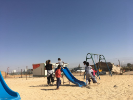Recent architecture grad takes her skills to Jordan to build foundation for the next generation

Lemma Al-Ghanem spent the summer on an Emergency Architecture and Human Rights' school-building project for Syrian refugees in Jordan. In addition to construction support, she served as a translator between Arabic speaking locals and English speaking team members. Here she helps translate as workers erect the school's first wall. Photos courtesy of Lemma Al-Ghanem and EAHR
By Brenna Zanghi
Published October 8, 2018 This content is archived.
Shortly after earning her Master of Architecture from UB's School of Architecture and Planning, Lemma Al-Ghanem headed to Jordan to join a humanitarian organization’s effort to build a sustainable classroom in Azraq Village.
A UB student since 2012, Al-Ghanem’s family is originally from Syria. In Jordan, Al-Ghanem took part in WORKSHOP 1 + 1=11, a program of the NGO Emergency Architecture and Human Rights (EAHR)'s "100 Schools for Refugee Children" project. Using low-cost, local materials and community expertise, the program seeks to increase classroom attendance of Syrian refugee children in Azraq village, located outside the Azraq refugee camp, today the second largest refugee camp in Jordan.
Al-Ghanem was one of 20 candidates selected for the program. She participated in all phases of construction as well as EAHR lectures on humanitarian architecture and debate.
The process relied heavily upon local labor and construction methods. For instance, the school's design draws from traditional Syrian rural architecture and was built out of compressed earth bricks. Syrian refugees from the nearby Zaatari camp comprised the majority of the construction team, while local Jordanians and foreign volunteers provided the rest.
In addition to helping with the construction, Al-Ghanem served as an Arabic-English translator between EAHR leaders and local residents. “Being able to speak Arabic helped me connect with many of the skilled workers on site and off. I have made friendships and learned a lot about the hardships they went through in Syria and Jordan, which has only fueled my desire to be part of the solution through design.”

A photograph by Salvador Gomis Aviño, one of the project's system experts, shows progress on the mud brick dome and the vaulted ceilings it will created for the classrooms.
Al-Ghanem says her graduate research experience as part of the Department of Architecture's Material Culture Research Group created a strong foundation for the low-tech, on-the-ground, problem-solving approach to design in Jordan. In fact, the Azraq school's brick system was very similar to a concrete compression project she explored under architecture professor Christopher Romano.
“I believe a material-heavy approach to architecture works well in disaster relief architecture because you’re usually working in a foreign land with very little resources and/or technology available to you. I am very grateful I have had the ability to focus on material building in school. The work I did in Jordan only further emphasized that this approach to architecture is not only a valid one, but one that works best when you’re directly on the ground building in those types of conditions.”
Al-Ghanen has since returned to Buffalo to complete her Graduate Certificate in Historic Preservation. Looking ahead, she says the experience in Jordan affirmed her interest in a career in humanitarian architecture.
“I am extremely grateful for the opportunity I was given to help out in Jordan. EAHR is doing amazing and extremely uplifting work. The experience is one I will carry with me for the rest of my life. It has taught me so much and validated the importance of the type of work I want to do. It has given me experience in being able to blend my love for humanitarian work as well as a material-heavy approach to architecture.”
-Lemma Al-Ghanem (MArch '18, Architecture BS '16)

Syrian refugee Nasser, whom Al-Ghanem befriended during the project, watches construction progress. Photo: Lemma Al-Ghanem
Emergency Architecture and Human Rights is a nonprofit organization with headquarters in Copenhagen, Rome and Santiago de Chile, building for those who face humanitarian emergencies, cultural conflicts, inequality and human right issue.
.jpg.thumb.100.140.jpg)

.jpg.thumb.100.140.jpg)



